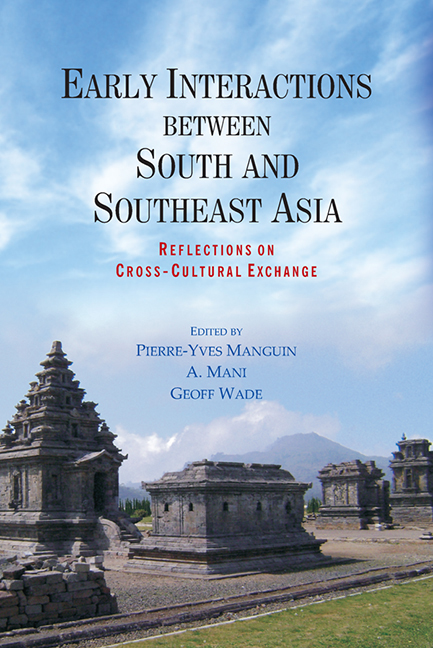Book contents
- Frontmatter
- Contents
- FOREWORD
- Preface
- Introduction
- PART I New Archaeological Evidence from South Asia and Southeast Asia
- PART II Localisation in Southeast Asia
- 11 Tamil Merchants and the Hindu-Buddhist Diaspora in Early Southeast Asia
- 12 The Spread of Sanskrit in Southeast Asia
- 13 The Early Inscriptions of Indonesia and the Problem of the Sanskrit Cosmopolis
- 14 Indian Architecture in the ‘Sanskrit Cosmopolis’: The Temples of the Dieng Plateau
- 15 The Importance of Gupta-period Sculpture in Southeast Asian Art History
- 16 Individuals under the Glaze: Local Transformations of Indianisation in the Decorative Lintels of Angkor
- 17 Early Musical Exchange between India and Southeast Asia
- 18 Buddhism and the Circulation of Ritual in Early Peninsular Southeast Asia
- 19 Early Buddhism in Myanmar: Ye Dhammā Inscriptions from Arakan
- 20 Hindu Deities in Southern Vietnam: Images on Small Archaeological Artefacts
- 21 ‘The Depositing of the Embryo’ – Temple Consecration Rituals in the Hindu Tradition of South and Southeast Asia: A Study of the Textual and Archaeological Evidence
- 22 Localisation of Indian Infl uences as Refl ected in the Laotian Versions of the Ramayana
- 23 Broken Threads: Contested Histories of Brahminism in Cambodia and Thailand and the Construction of Ritual Authority
- LIST OF CONTRIBUTORS
- INDEX
17 - Early Musical Exchange between India and Southeast Asia
from PART II - Localisation in Southeast Asia
Published online by Cambridge University Press: 21 October 2015
- Frontmatter
- Contents
- FOREWORD
- Preface
- Introduction
- PART I New Archaeological Evidence from South Asia and Southeast Asia
- PART II Localisation in Southeast Asia
- 11 Tamil Merchants and the Hindu-Buddhist Diaspora in Early Southeast Asia
- 12 The Spread of Sanskrit in Southeast Asia
- 13 The Early Inscriptions of Indonesia and the Problem of the Sanskrit Cosmopolis
- 14 Indian Architecture in the ‘Sanskrit Cosmopolis’: The Temples of the Dieng Plateau
- 15 The Importance of Gupta-period Sculpture in Southeast Asian Art History
- 16 Individuals under the Glaze: Local Transformations of Indianisation in the Decorative Lintels of Angkor
- 17 Early Musical Exchange between India and Southeast Asia
- 18 Buddhism and the Circulation of Ritual in Early Peninsular Southeast Asia
- 19 Early Buddhism in Myanmar: Ye Dhammā Inscriptions from Arakan
- 20 Hindu Deities in Southern Vietnam: Images on Small Archaeological Artefacts
- 21 ‘The Depositing of the Embryo’ – Temple Consecration Rituals in the Hindu Tradition of South and Southeast Asia: A Study of the Textual and Archaeological Evidence
- 22 Localisation of Indian Infl uences as Refl ected in the Laotian Versions of the Ramayana
- 23 Broken Threads: Contested Histories of Brahminism in Cambodia and Thailand and the Construction of Ritual Authority
- LIST OF CONTRIBUTORS
- INDEX
Summary
From the first centuries CE, the more important relations between Southeast Asia and India can be found in the shastras (religion, scripts, literature, politics, law) and architecture (Coedès 1968: 254-56), while that with China, Korea and Japan, in music structures, musical instruments and ensembles (Picken 1981-90; Maceda 1995d). In Southeast Asia, after an extended period of adapting Hindu and Buddhist rites and ceremonies, courts and temples developed a parallel repertoire of music for court ceremonies, separate from the repertoire used for religious rites in the temples. In Java and Bali, the extensive use of musical forms, musical instruments and vocal music attested to in Old Javanese and Old Balinese inscriptions, literatures, and in temple reliefs (Kunst 1968), as can also be found in Burma, Thailand, Laos, Kampuchea, and Vietnam, are early records of music in the area. Religious transformation in the two islands of Java and Bali allowed for the reworking and recasting of old rites into new forms suitable for Hindu or Buddhist ceremonies both in the temples and in the courts. The manifold reworking of rites and ceremonies, and how the musical arts were integrated into these systems has yet to be described and analysed – what indigenous structures were perceived to be malleable for new Hindu and Buddhist liturgical forms, and how these were all incorporated into the ritual repertoire of both the courts and the temples and other sacred sanctuaries, and what musical, theatrical or dance forms were integrated into these systems.
If the courts and the temples exuded an aura of exclusivity and sacrality, the surrounding villages which constituted an even larger system nurtured their own musical traditions, rites and festivities that were of two orientations – the persistence of indigenous repertoire, and the slow intrusion of Hindu, Buddhist, Islamic and Christian modes of ritual and ceremonial procedures. In these contexts, the musics of Southeast Asia developed into at least three distinct areas: first, the village which until today remains the repository of ancient religious and musical practices; second, the courts; and third, the temples, which together established a new form of centralised organisation and power, and consequently assumed the position as centres of musical activity, where musicians and dancers, players and puppeteers were employed in the service of the ruler, the aristocracy and the religious hierarchy.
- Type
- Chapter
- Information
- Early Interactions between South and Southeast AsiaReflections on Cross-Cultural Exchange, pp. 347 - 370Publisher: ISEAS–Yusof Ishak InstitutePrint publication year: 2011



